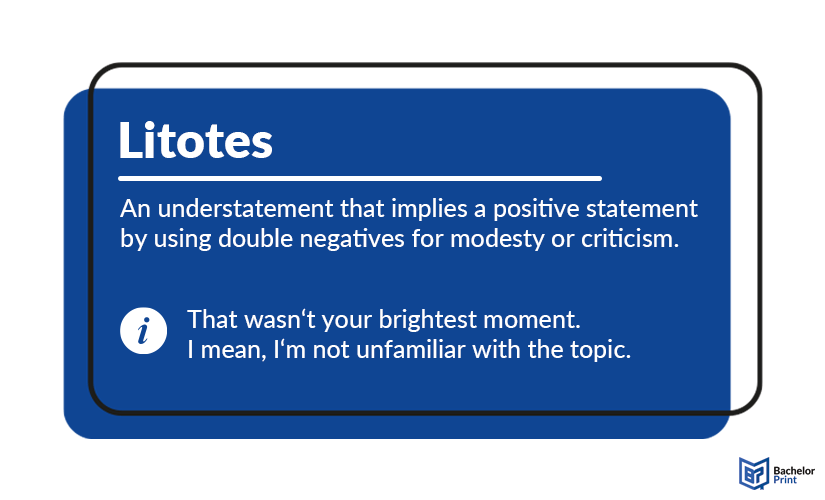
Litotes, an understatement through double negatives, subtly transforms language with its unique emphasis and tonal nuances. Unlike direct statements, litotes invite readers into a space of reflection and profound understanding. Its distinct approach sets it apart by offering a delicate balance between saying less and implying more. This article aims to explore its essence, delineate its impact, distinguish it from other rhetorical strategies, and highlight its application in academic writing.
Definition: Litotes
The origin of the stylistic device “litotes” derives from the Greek words “λιτός” or “litos,” implying simplicity or plainness, which aligns with the rhetorical tool’s nature of understatement by using double negatives or negating the opposite, thereby implying a positive statement indirectly.
This rhetorical device allows the speaker or writer to express a thought, sentiment or statement in a subtle, often more diplomatic or modest manner. It’s a common technique in everyday language and various forms of literature and rhetoric, enabling the conveyance of a point with understated emphasis. Typically, adding a layer of irony or intensifying the impact of what is being communicated without overtly stating it.
When it comes to academic essays, litotes should be omitted because it obscures the meaning and makes statements unnecessarily complex.
To further your understanding of litotes, below you’ll find a few examples.

Litotes: Examples
Litotes can be found across various aspects of communication, enriching language with its understated emphasis. Here are three examples of litotes spanning different categories, including everyday life, literature, and formal speeches, to illustrate its versatility.
In our day-to-day interactions, litotes serve as a gentle tool for softening statements, allowing us to express ourselves with modesty and diplomacy.
English literature and poetry frequently harness the power of litotes to add layers of meaning, subtly enhancing character descriptions and settings with understated elegance. Below, you’ll find several famous litotes used in literature.
Formal speeches, whether in politics, academia, or business, utilize this rhetorical tool to convey confidence and underscore achievements with a tone of measured optimism and restraint.
In the realm of marketing, litotes are strategically employed to underscore the appeal of products and services, crafting messages that resonate with consumers by implying superiority without overt boasting.
Within media narratives, from news to entertainment, this literary device plays a crucial role in shaping public perception, offering nuanced commentary that engages audiences with implied significance.
Litotes in common expressions
As mentioned before, this figure of speech is commonly used in daily speech; however, there are expressions that function similarly as both litotes and idioms. Some are listed below, along with their meanings.
Litotes in other languages
Litotes can also be found in other languages. Below are two examples of this literary device in French, Spanish, and German.
Functions
Functions refer to the intended purposes or roles that litotes serve in speech or writing. This aspect focuses on why speakers or writers strategically choose to use them. The functions are listed below.
Emphasizing modesty or humility
This type of litotes is used to downplay one’s achievements or qualities to appear modest or humble.
Softening criticism
Here, understatements are employed to deliver criticism less directly and more softly, which can make the critique more palatable.
Highlighting understatement
In this use, litotes dramatically understate a fact or situation to draw attention to its opposite or the extremeness of the situation.
Expressing irony or sarcasm
Utilized to convey irony or sarcasm, offering a statement that appears to understate but is understood to imply the opposite or to carry a critical tone.
Effects
Effects pertain to the impact or outcome that litotes have on the audience or reader. The effect is about the reception and consequence of using them in communication.
While they can be conceptualized separately for analytical purposes, in practice, the function of a rhetorical device like litotes is closely tied to its effect on communication and interpretation.
Below, you’ll find a list showing the purpose, and the achieved effect of understatements with examples.
| Effect | Litotes | Actual meaning |
| Shows the receiver that the speaker expresses modesty without boasting. | ||
| Sounds a lot more acceptable to the receiver. | It isn't my cup of tea. | I don’t like it. |
| Makes the receiver take special note by understating its presence or impact. | He's not a bad singer. | He’s a good singer. |
| Shows the receiver disapproval without direct criticism. |
Tropes
Tropes are literary devices that extend beyond the literal meanings of words or phrases to convey complex ideas with greater depth and nuance. These enrich language through figures of speech that include hyperboles, irony, metaphors, and litotes, inviting deeper interpretation and engagement.
By leveraging tropes, writers, and speakers can evoke vivid imagery, stir emotions, and subtly influence perceptions, making language more dynamic and expressive. Below, we will show you examples of the most commonly used tropes, and their meanings, together with examples.
Understatement or double negation, so the opposite of a hyperbole, often used to emphasize something in a reserved or indirect manner.
A euphemism is a polite, mild, or indirect expression substituted for one considered to be too harsh.
A dysphemism describes the use of a derogatory or unpleasant term instead of a pleasant or neutral one, often to shock or offend. It is the antonym of euphemism.
A rhetorical question is a question asked for effect or to make a statement rather than to gain insight.
Literary combinations
Litotes, when combined with other literary devices, can enrich the depth of language, offering nuanced ways to convey meaning, tone, and emphasis. Here are several combinations of understatements with other literary devices, along with examples for each.
Litotes & metaphor
Combining litotes with a metaphor allows for the understated expression of ideas through imaginative comparisons, enhancing the subtlety and richness of the message.
In the first example, the litotes “not unlike” softens the comparison, while the metaphor compares a person to a lion to imply bravery and ferocity.
In the second example, the use of the double negative “not unlike” combined with the metaphor “soothing balm” subtly emphasizes the comforting effect of her speech.
Litotes & irony
Litotes used in combination with irony can create a sophisticated layer of meaning, where the ironic understatement contrasts sharply with the expected or literal meaning, often producing a humorous or critical effect.
In the first example, “not the best” is an understatement for a disastrous outcome, used ironically to criticize a poor decision.
In the second example, “isn’t exactly unlucky” ironically downplays the severe misfortune of the situation, highlighting the absurdity.
Litotes & hyperbole
The combination of litotes and hyperbole involves pairing understatement with exaggeration to create a striking contrast or to intensify the effect of the statement.
In the first sentence, “isn’t dry” understates the obvious truth about the ocean, while “a bit of a sports enthusiast” is an understatement for extreme passion, creating a humorous exaggeration of his interest in sports.
In the second sentence, the understatement “not unfamiliar” combined with the hyperbolic frequency “as often as the sun rises” emphasizes her regularity in visiting the library.
Litotes & simile
When these two rhetorical devices are used, the similar comparison made by the simile is nuanced by the understatement, allowing for a delicate and often more relatable expression.
In the first phrase, the double negative “not unlike eating at a five-star restaurant” subtly praises her cooking skills, while the simile “as comforting as home” adds a personal, relatable touch.
In the second example sentence, the comparison of his patience to a saint, moderated by “not unlike,” and further compared to “a serene lake” using a simile, emphasizes his remarkable patience in a layered, vivid manner.
Litotes vs. meiosis
Litotes and meiosis are both figures of speech used to convey an understatement, but they accomplish this by using slightly different mechanisms and serve distinct purposes in rhetoric and literature.
A meiosis is a rhetorical device that deliberately understates, minimizes or diminishes the importance or magnitude of something, often for ironic purposes or to downplay a situation. Unlike litotes, which negates the opposite, meiosis directly minimizes the subject without necessarily employing negation.
Common litotes typically imply a positive assertion indirectly, whereas meiosis tends to downplay or belittle its subject more straightforwardly.
Below are several examples of meiosis, that clearly show the difference.
- ✓ 3D live preview of your individual configuration
- ✓ Free express delivery for every single purchase
- ✓ Top-notch bindings with customised embossing

FAQs
It is a figure of speech that uses a form of understatement for emphasis. For example, someone might say to you that they “don’t not like your cooking.” The double negative would indicate that they do like your cooking, but want to be subtle about it, instead of directly complimenting your food.
Another word for it is an understatement. It articulates something negatively but is intended to express something positive. The antonym would be the hyperbole, which is an exaggeration.
It is often used to soften criticism, avoid an issue, or showcase a humorous understatement in English phrases.
